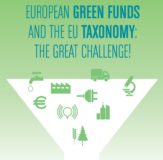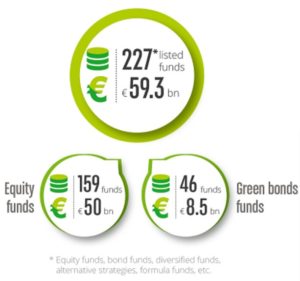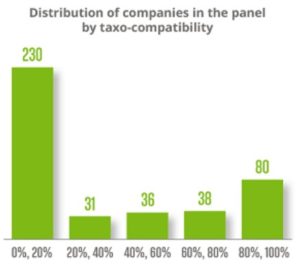
Bron
Novethic
Novethic, with the support of ADEME, announces the publication of its study: “European Green Funds and the EU Taxonomy: the Great Challenge!” It outlines a booming market with 227 funds for €59.3 billion in assets that will have to assess their compliance with the European sustainable activities standard, known as the Taxonomy. Novethic’s study shows that funds will need to transform their selection and reporting methods to align with Europe’s environmental objectives.
The green fund offer is growing in Europe
 In two years, the volume of assets invested in funds promoting an environmental strategy in Europe has almost doubled. It exceeded €30 billion at the end of 2017 and reached almost €60 billion at the end of 2019. This growth should be put into perspective since these green funds represent less than 1% of the funds managed by European asset managers. But their analysis allows us to understand the development of environmental signposts in asset management, which is primarily concerned by the implementation of the EU Taxonomy. Novethic’s study outlines the main characteristics of this predominantly equity market and serves as an educational presentation of the Taxonomy and how it could be implemented through a “taxo-compatibility” assessment of
In two years, the volume of assets invested in funds promoting an environmental strategy in Europe has almost doubled. It exceeded €30 billion at the end of 2017 and reached almost €60 billion at the end of 2019. This growth should be put into perspective since these green funds represent less than 1% of the funds managed by European asset managers. But their analysis allows us to understand the development of environmental signposts in asset management, which is primarily concerned by the implementation of the EU Taxonomy. Novethic’s study outlines the main characteristics of this predominantly equity market and serves as an educational presentation of the Taxonomy and how it could be implemented through a “taxo-compatibility” assessment of
the panel’s equity funds.
The “taxo-compatible” share of European green equity funds is less than 30%
Funds with an environmental strategy – whether they are equities or bonds – choose assets according to green criteria, which vary considerably from one manager to another. Regarding bonds, funds are essentially green bond funds that invest more than 80% in green bonds that invest in projects selected for their environmental objectives. Although, the same is not true for equity funds.
To assess the investments’ alignment with the Taxonomy, it is necessary to analyze the activity of the companies selected in the portfolios. However, the environmental criteria applied by asset managers are broad. Criteria may concern corporate activities, especially when it comes to renewable energy or environmental services, but also environmental management or reporting of companies in other sectors. Still, the Taxonomy brings a new way of evaluating corporate environmental performance. Corporate activities and products aligned with the Taxonomy must comply with the European Union’s environmental objectives, according to the technical standards defined by the standard. The Taxonomy currently only covers mitigation and adaptation to climate change, but still makes it possible to assess the environmental qualities of green funds based on this new lens.
Lack of information from companies hinders deployment of the Taxonomy
 Novethic carefully vetted public communications from the 415 listed European companies most commonly found in European green equity funds. Analysts noted that it is very difficult to find information on the breakdown of company turnover by Taxonomy-eligible activities. By applying a filter per activity, and without going into more technical details concerning thresholds, we found that a majority of companies in green funds have a low share of taxo-compatible activities (less than 20%). In many cases, the lack of company transparency makes it impossible to assess the share of turnover potentially compatible with the Taxonomy.
Novethic carefully vetted public communications from the 415 listed European companies most commonly found in European green equity funds. Analysts noted that it is very difficult to find information on the breakdown of company turnover by Taxonomy-eligible activities. By applying a filter per activity, and without going into more technical details concerning thresholds, we found that a majority of companies in green funds have a low share of taxo-compatible activities (less than 20%). In many cases, the lack of company transparency makes it impossible to assess the share of turnover potentially compatible with the Taxonomy.
Align European regulations, including their timetables
The Novethic study “European Green Funds and the EU Taxonomy: the Great Challenge!” highlights how far there is to go to make the Taxonomy a tool for greening the European economy. This will only be possible if European regulations are aligned to provide the necessary environmental information. For companies, this is the NFRD (Non-Financial Reporting Directive), and for investors, it is the SFDR (Sustainable Finance Disclosure Regulation). The former is to be revised during 2021, the latter is waiting for its delegated acts to specify the implementation of these new obligations. In principle, both companies and investors should devote 2021 to preparing for the environmental paradigm shift represented by the Taxonomy.



